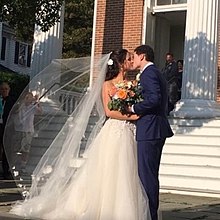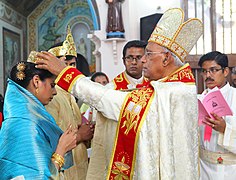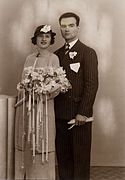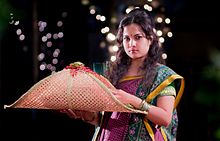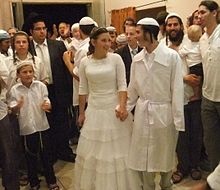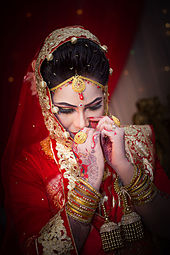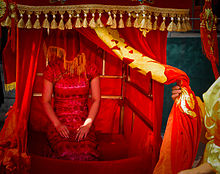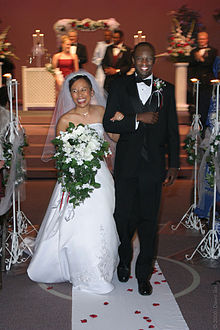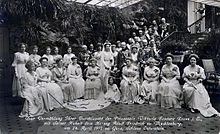A wedding is a ceremony where two people are united in marriage. Wedding traditions and customs vary greatly between cultures, ethnic groups, religions, countries, and social classes. Most wedding ceremonies involve an exchange of marriage vows by a couple, presentation of a gift (offering, rings, symbolic item, flowers, money, dress), and a public proclamation of marriage by an authority figure or celebrant. Special wedding garments are often worn, and the ceremony is sometimes followed by a wedding reception. Music, poetry, prayers, or readings from religious texts or literature are also commonly incorporated into the ceremony, as well as superstitious customs.
Common elements across cultures[edit]
Some cultures have adopted the traditional Western custom of the white wedding, in which a bride wears a white wedding dress and veil. This tradition was popularized through the marriage of Queen Victoria.[1] Some say Queen Victoria’s choice of a white gown may have simply been a sign of extravagance, but may have also been influenced by the values she held which emphasized sexual purity.[2]
The use of a wedding ring has long been part of religious weddings in Europe and America, but the origin of the tradition is unclear. One possibility is the Roman belief in the Vena amoris, which was believed to be a blood vessel that ran from the fourth finger (ring finger) directly to the heart. Thus, when a couple wore rings on this finger, their hearts were connected. Historian Vicki Howard points out that the belief in the «ancient» quality of the practice is most likely a modern invention.[3] In the United States of America, a groom’s wedding band has not appeared until the early 20th century,[4] while in Europe it has been part of the tradition since the ancient Romans, as witnessed by the jurist Gaius.
The exit from the wedding ceremony is also called the «send off», and often includes traditional practices, such as the newlyweds and the wedding party bowing and kissing the knees of the elders in Ethiopian weddings. The send off often includes throwing rice (a symbol of prosperity and fertility)[5] or other seeds at the newlyweds in most of the Western world,[6] as well as for example India[5] and Malaysia.[7] Despite fears of the opposite, the use of uncooked rice for this purpose is not harmful to birds.[8] Shoe tossing in place of rice has also been used in several cultures.[9]
The wedding ceremony is often followed by wedding reception or a wedding breakfast, in which the rituals may include speeches from a groom, best man, father of a bride and possibly a bride,[10] the newlyweds’ first dance as a couple, and the cutting of an elegant wedding cake. In recent years traditions have changed to include a father-daughter dance for a bride and her father, and sometimes also a mother-son dance for a groom and his mother.
Locations[edit]
In some countries there are restictions on where a wedding may take place, for example before the Marriage Act 1994, marriages in England and Wales could only take place in authorised religious buildings or civil register offices, but the Act extended the options available to allow weddings in other «approved premises».[11] Cretney identified a wide range of venues which sought approval after the implementation of this legal change, including hotels, stately homes, football grounds and former warships. Related outdoor locations could also be approved for weddings after the Marriages and Civil Partnerships (Approved Premises) (Amendment) Regulations 2022 were adopted.[12]
Traditional wedding attire[edit]
- Western dress code
- Wedding dress (or bridal gown), a special dress worn by a bride.
-
Traditional western wedding veil
Wedding veil, popularized by Queen Victoria, was a long-held custom in which the ‘purity’ and ‘innocence’ of the bride could thwart evil spirits.
- Morning dress, western daytime formal dress
- White tie («evening dress» in the U.K; very formal evening attire)
- Black tie or Evening Suit («dinner jacket» in the U.K; often referred to as a «tuxedo» in the U.S. and Canada; traditionally appropriate only for use after 6:00 p.m.
- Stroller
- Lounge suit
- Non-traditional «tuxedo» variants (colored jackets/ties, «wedding suits»)
- Ao dai, traditional garments of Vietnam
- Barong Tagalog, an embroidered, formal men’s garment of the Philippines
- Batik and Kebaya, a garment worn by the Javanese people of Indonesia and also by the Malay people of Malaysia
- Dashiki, the traditional West African wedding attire
- Dhoti, male garment in South India
- Hanbok, the traditional garment of Korea
- Kilt, male garment particular to Scottish culture[13][14][15]
- Kittel, a white robe worn by the groom at an Orthodox Jewish wedding. The kittel is worn only under the chuppah, and is removed before the reception.
- Qun Gua or Kua (裙褂 pinyin qún guà, Cantonese kwàhn kwáa), Chinese traditional formal wear. This can be in the form of a qipao or hanfu.
- Ribbon shirt, often worn by Native American men on auspicious occasions, such as weddings, another common custom is to wrap bride and groom in a blanket
- Sampot, traditional dress in Cambodia
- Sari/Lehenga, Indian popular and traditional dress in India
- Seshweshe, a female dress worn by the Basotho women during special ceremonies. Although it has recently been adopted to men attire as well.
- Sherwani, a long coat-like garment worn in South Asia
- Shiromuku Kimono, a traditional wedding garment in Japan
- Tiara, or wedding crown, worn by Syrian and Greek couples (which are called «τα στέφανα,» which literally means «wreaths») and Scandinavian brides
- Topor, a type of conical headgear traditionally worn by grooms as part of the Bengali Hindu wedding ceremony
- Different wedding clothing around the world
-
Khmer (Cambodian) wedding in traditional outfits
-
A bride and a bridegroom in Nepal
-
-
-
Japanese bride and bridegroom
-
-
-
-
Wedding 1935 in Barcelona, Spain
-
-
-
Groom in the traditional dress of Bangladesh in a wedding ceremony.
-
Armenian Wedding at Khor Virap
-
Aadiwasi tribal marriage groom bride, India
-
Wedding in Turkey
Wedding music[edit]
Western weddings[edit]
Music played at Western weddings includes a processional song for walking down the aisle (ex: wedding march) either before or after the marriage service. An example of such use is reported in the wedding of Nora Robinson and Alexander Kirkman Finlay in 1878.[16]
The «Bridal Chorus» from Lohengrin by Richard Wagner, commonly known as «Here Comes the Bride», is often used as the processional. Wagner is said to have been anti-Semitic,[17] and as a result, the Bridal Chorus is normally not used at Jewish weddings.[18] UK law forbids music with any religious connotations to be used in a civil ceremony.[19]
Johann Pachelbel’s Canon in D is an alternative processional.[20] Other alternatives include various contemporary melodies, such as Bob Marley’s One Love, which is sometimes performed by a steel drum band.[4] The Music used in modern weddings is left completely up to the Bride and Groom and it is also becoming growingly popular for couples to add their own twist to the song they walk down the aisle to. Many Brides and Grooms use songs that are sentimental or hold special value to them.
In the United States, approximately 2 million people get married each year and close to 70 million people attend a wedding and spend more than $100 on a gift.[21]
In the United Kingdom, according to a survey, the average spend minimum spend on a wedding gift[22] is £24.70 and the average maximum spend is £111.46. 85% of people said that they were more likely to spend more money on a person if they had a better relationship with them.
Customs associated with various religions and cultures[edit]
Christian customs[edit]
Most Christian churches give some form of blessing to a marriage, which is seen as a sacred institution in some sense, although terminology and associated theological meanings vary widely from one denomination to another: e.g., «holy matrimony,» «sacrament of marriage,» «holy ordinance of marriage,» «holy union,» and so forth.
A celebration of Holy Matrimony typically includes mutual vows or solemn promises of lifelong love and fidelity by the couple, and may include some sort of pledge by the community to support the couple’s relationship. A church wedding is a ceremony held in a church and presided over by a Christian pastor. Traditionally, Christian weddings occur in a church as Christian marriage ideally begins where one also starts their faith journey (Christians receive the sacrament of baptism in church in the presence of their congregation).[23] Catholic Christian weddings must «take place in a church building» as holy matrimony is a sacrament; sacraments normatively occur in the presence of Christ in the house of God, and «members of the faith community [should be] present to witness the event and provide support and encouragement for those celebrating the sacrament.»[23] Bishops never grant permission «to those requesting to be married in a garden, on the beach, or some other place outside of the church» and a dispensation is only granted «in extraordinary circumstances (for example, if a bride or groom is ill or disabled and unable to come to the church).»[23] Marriage in the church, for Christians, is seen as contributing to the fruit of the newlywed couple regularly attending church each Lord’s Day and raising children in the faith.[23]
Wedding ceremonies typically contain prayers and readings from the Holy Bible and reflect the church’s teachings about the spiritual significance of marriage, as well as its purpose and obligations. The wedding service often includes the reception of Holy Communion, especially in the context of Mass (as with Catholicism, Lutheranism, and Anglicanism).[24] In some traditional weddings of Western Christianity (especially Catholicism, Lutheranism and Anglicanism), a ‘care cloth’ or ‘nuptial veil’ (velatio nuptialis) «signifying a marriage yoke joining the bride and groom together» may be held over the kneeling couple during the nuptial blessing given by the priest.[25][26][27][28][29]
Pre-marital counseling may be urged or required for the engaged couple.[30] In some Christian countries or denominations, a betrothal rite, as well as the reading of banns of marriage may also be required before the wedding date.[31]
In the Roman Catholic Church, Holy Matrimony is considered to be one of the seven sacraments, in this case, one that the spouses bestow upon each other in front of a priest and members of the community as witnesses. As with all sacraments, it is seen as having been instituted by Jesus himself (see Gospel of Matthew 19:1–2, Catechism of the Catholic Church §1614–1615). In the Eastern Orthodox Church, it is one of the Mysteries and is seen as an ordination and a martyrdom. The Christian wedding ceremony of Saint Thomas Christians, an ethnoreligious group of Christians in India, incorporates elements from local Indian traditions. Protestant weddings may be elaborate (as with Lutheranism and Anglicanism) or simple (as with Baptists). For example, in the United Methodist Church, the Service of Christian Marriage (Rite I) includes the elements found in a typical Sunday service, such as hymns, prayers, and readings from the Bible, as well as other elements unique to a wedding, including taking marriage vows and an optional exchange of wedding rings, as well as a special benediction for the couple.[32] Holy Communion may be part of the wedding service in liturgical Protestant churches (e.g., Lutheran, Anglican, or Methodist), but is rarely, if ever, found in weddings of other low-church Protestant denominations (e.g., Baptists).
A Quaker wedding ceremony in a Friends meeting is similar to any other meeting for worship, and therefore often very different from the experience expected by non-Friends.[33]
In some Western countries, a separate and secular civil wedding ceremony is required for recognition by the state, while in other Western countries, couples must merely obtain a marriage license from a local government authority and can be married by Christian or other clergy authorized by law to do so.
Since the beginning of the 21st century, same-sex couples have been allowed to marry civilly in many countries, and some Christian churches in those countries allow religious marriages of same-sex couples, though some forbid it. See the article Same-sex marriage.
Hindu customs[edit]
A girl with the traditional gift of Gaye holud.
Bridegroom arrives on horseback at a Rajput wedding
Hindu ceremonies are usually conducted totally or at least partially in Sanskrit, the language of the Hindu scriptures. The wedding celebrations may last for several days and they can be extremely diverse, depending upon the region, denomination, and community. Mehendi ceremony is a traditional ritual in Hindu weddings, where Henna application takes place on the bride’s hands and legs, before the wedding. On the wedding day, the bride and the bridegroom garland each other in front of the guests. Most guests witness only this short ceremony and then socialize, have food, and leave. The religious part (if applicable) comes hours later, witnessed by close friends and relatives. In cases where a religious ceremony is present, a Brahmin (Hindu priest) arranges a sacred yajna (fire-sacrifice), and the sacred fire (Agni) is considered the prime witness (sākshī) of the marriage. He chants mantras from the Vedas and subsidiary texts while the couple is seated before the fire. The most important step is saptapadi or saat phere, wherein the bride and the groom, hand-in-hand, encircle the sacred fire seven times, each circle representing a matrimonial vow. Then the groom marks the bride’s hair parting with vermilion (sindoor) and puts a gold necklace (mangalsutra) around her neck. Or a yellow thread applied with turmeric is knotted around the bride’s neck 3 times at marriage. The first knot represents her obedience and respect to her husband, the second one to his parents and the third represents her respect to God. Several other rituals may precede or follow these afore-mentioned rites. Then the bride formally departs from her blood-relatives to join the groom’s family.
Jewish customs[edit]
A traditional Jewish wedding usually follows this format:[34][35][36][37][38]
- Before the ceremony, the couple formalize a written ketubah (marriage contract), specifying the obligations of husband to the wife and contingencies in case of divorce. The ketubah is signed by two witnesses and later read under the chuppah (wedding canopy).
- The couple is married under the chuppah signifying their new home together. The chuppah can be made from a piece of cloth or other material attached to four poles, or a giant tallit (prayer shawl) held over the couple by four family members or friends.
- The wedding couple is accompanied by both sets of parents and they join the wedding couple under the chuppah.
- In Orthodox Jewish weddings, the bride is accompanied to the chuppah by both mothers, and the groom is accompanied to the chuppah by both fathers.
- Seven blessings are recited, blessing the bride and groom and their new home.
- The couple sip a glass of wine from a Kiddush cup.
- The groom will smash a wine glass with his right foot, ostensibly in remembrance of the destruction of the Second Temple.
- In Reform Jewish weddings, the bride and groom can smash the wine glass together.
- At some weddings, the couple may declare that each is sanctified to the other, repeat other vows and exchange rings.
- In Orthodox Jewish weddings, the bride does not speak under the chuppah and only she receives a ring. The groom recites «Harei at mekudeshet li k’dat Moshe V’Yisrael»- «behold you are [thus] sanctified to me by the law of Moses and Israel» as he places the ring on the bride’s right index finger. The bride’s silence and acceptance of the ring signify her agreement to the marriage. This part of the ceremony is called kiddushin. The groom’s giving an object of value to the bride is necessary for the wedding to be valid.
- In more egalitarian weddings, the bride responds verbally, often giving the groom a ring in return. A common response is «ani l’dodi, v’dodi li» (I am my beloved’s, my beloved is mine)
- In some Orthodox weddings, the groom then says:
- «If I forget you, O Jerusalem, may my right hand forget its skill.
- May my tongue cling to the roof of my mouth.
- If I do not remember you,
- if I do not consider Jerusalem in my highest joy.»
- The ceremony ends with the groom breaking a glass underfoot.
- The couple spend their first moments as husband and wife in seclusion (apart from the wedding guests, and with no other person present). This cheder yichud – «the room of seclusion (or ‘oneness’)» halachically strengthens the marriage bond since Orthodox Jews are forbidden to be secluded with an unrelated person of the opposite sex.
- The ceremony is followed by a seudat mitzvah, the wedding meal, as well as music and dancing.
- At the conclusion of the wedding meal, Birkat Hamazon (Grace After Meals) is recited, as well as the seven wedding blessings.
In more observant communities, the couple will celebrate for seven more days, called the Sheva Brachot (seven blessings) during which the seven wedding blessings are recited at every large gathering during this time.
Islamic customs[edit]
Henna on the hands of a bride in Tunisia
A wedding is typically a happy time for families to celebrate. In the Middle East, there are colorful, cultural variations from place to place.[39]
Two male witnesses who are the members of the family in most cases are required for Nikah. According to the Quran, in a married Muslim couple, both husband and wife act as each other’s protector and comforter and therefore only meant «for each other».
All Muslim marriages have to be declared publicly and are never to be undertaken in secret. For many Muslims, it is the ceremony that counts as the actual wedding alongside a confirmation of that wedding in a registry office according to fiqh. In Islam a wedding is also viewed as a legal contract particularly in Islamic jurisprudences. However, most Muslim cultures separate both the institutions of the mosque and marriage; no religious official is necessary, but very often an Imam presides and performs the ceremony, he may deliver a short sermon.[40] Celebrations may differ from country to country depending on their culture but the main ceremony is followed by a Walima (the marriage banquet).
In Islam, polygyny is allowed with certain religious restrictions. Despite that, an overwhelming majority of Muslims traditionally practice monogamy.
It is forbidden in Islam for parents or anyone else: to force, coerce, or trick either man or woman into a marriage that is contrary to the individual will of any one of the couples. It is also necessary for all marriages to commence with the best of intentions.
Chinese customs[edit]
In traditional Chinese wedding ceremonies, bride arrives in a jiao
At traditional Chinese weddings, the tea ceremony is the equivalent of an exchange of vows at a Western wedding ceremony. This ritual is still practiced widely among rural Chinese; however, young people in larger cities, as well as in Taiwan, Hong Kong, Malaysia, and Singapore, tend to practice a combination of Western style of marriage together with the tea ceremony.
When the bride leaves her home with the groom to his house, a «Good Luck Woman» will hold a red umbrella over her head, meaning, «Raise the bark, spread the leaves.» This «Good Luck Woman» should be someone who is blessed with a good marriage, healthy children, and husband and living parents. Other relatives will scatter rice, red beans, and green beans in front of her. The red umbrella protects the bride from evil spirits, and the rice and beans are to attract the attention of the gold chicken.[41]
The newlyweds kneel in front of parents presenting tea. A Good Luck Woman making the tea says auspicious phrases to bless the newlyweds and their families. The newlyweds also present tea to each other, raising the tea cups high to show respect before presenting the tea to each other.
The attendants receiving the tea usually give the bride gifts such as jewelry or a red envelope.
The tea ceremony is an official ritual to introduce the newlyweds to each other’s family, and a way for newlyweds to show respect and appreciation to their parents. The newlyweds kneel in front of their parents, serving tea to both sides of parents, as well as elder close relatives. Parents give their words of blessing and gifts to the newlyweds.
Humanist weddings[edit]
While many wedding traditions and rituals have origins in religions and are still performed by religious leaders, some marriage traditions are cultural and predate the prevalent religions in those regions. Non-religious people will often want to have a wedding that is secular (not religious) in content. In order to meet this demand, secular ceremonies by carried out by humanist celebrants first developed in the 19th century. Humanists UK members pioneered humanist weddings in the 1890s, and its weddings continue to be popular with couples across England, Wales, and Northern Ireland. In Scotland, Humanist Society Scotland (HSS) has carried out secular ceremonies in the country since the 1980s. These have been legally recognised since 2005,[42] and became more numerous than church weddings in 2018.[43][44]
Humanist wedding ceremonies are carried out in a variety of countries like the U.S., Canada and recently Brazil, having legal status in only a few of these countries. Humanist celebrants are able to perform valid civil marriages and civil partnerships in the Republic of Ireland. Secular weddings are becoming more popular in Ireland due to a declining influence of the Catholic Church.[45] Since 2015, Irish humanists have conducted more weddings than the Church of Ireland.[46]
A 2004 California wedding between a Filipina bride and a Nigerian groom.
Types[edit]
There are many ways to categorize weddings, such as by the size or cultural traditions. A wedding may fall into several categories, such as a destination microwedding, or a civil elopement.
White wedding[edit]
A white wedding is a term for a traditional formal or semi-formal Western wedding. This term refers to the color of the wedding dress, which became popular after Queen Victoria wore a pure white gown when she married Prince Albert and many were quick to copy her choice.[1] At the time, the color white symbolized both extravagance and virginal purity to many and had become the color for use by young women being formally presented to the royal court.[2]
Civil wedding[edit]
A civil wedding is a ceremony presided over by a local civil authority, such as an elected or appointed judge, Justice of the peace or the mayor of a locality. Civil wedding ceremonies may use references to God or a deity (except in U.K law where readings and music are also restricted), but generally no references to a particular religion or denomination.
Civil weddings allow partners of different faiths to marry without one partner converting to the other partner’s religion.
They can be either elaborate or simple. Many civil wedding ceremonies take place in local town or city halls or courthouses in judges’ chambers.
The relevance of civil weddings varies greatly from country to country. Some countries do not provide any form of civil wedding at all (Israel and many Islamic countries), while in others it is the only legally recognized form of marriage (most countries in Latin America, Europe, and Asia). In this case civil weddings are typically either a mandatory prerequisite for any religious ceremony or religious weddings have no legal significance at all. See Civil marriage.[47]
Destination wedding[edit]
Not to be confused with an elopement, a destination wedding is one in which a wedding is hosted, often in a vacation-like setting, at a location to which most of the invited guests must travel and often stay for several days. This could be a beach ceremony in the tropics, a lavish event in a metropolitan resort, or a simple ceremony at the home of a geographically distant friend or relative. During the recession of 2009, destination weddings continued to see growth compared to traditional weddings, as the typically smaller size results in lower costs.[48]
Weddings held at prestigious venues such as castles or stately homes have become increasingly popular in the 21st century particularly in European countries such as the UK, France and Germany. From 2010 onwards, there has been an increase in destination weddings that are hosted in exotic places like Indonesia, Maldives, India, and Pakistan.
Destination weddings are prohibited in certain denominations of Christianity, such as the Catholic Church, which teach that Christian marriages should take place in the presence of God at church, where Christians began their journey of faith in the sacrament of baptism.[23]
Double wedding[edit]
A double wedding is a double ceremony where two affianced couples rendezvous for two simultaneous or consecutive weddings. Typically, a fiancé with a sibling who is also engaged, or four close friends in which both couples within the friendship are engaged might plan a double wedding where both couples legally marry.
Elopement[edit]
Elopement is the act of getting married, often unexpectedly, without inviting guests to the wedding. In some cases, a small group of family or friends may be present, while in others, the engaged couple may marry without the consent or knowledge of parents or others. While the couple may or may not be widely known to be engaged prior to the elopement, the wedding itself is generally a surprise to those who are later informed of its occurrence.
Handfasting[edit]
A handfasting is an old pagan custom, dating back to the time of the ancient Celts. A handfasting was originally more like an engagement period, where two people would declare a binding union between themselves for a year and a day. The original handfasting was a trial marriage.[49]
Highland or Scottish wedding[edit]
The groom and one other in the wedding party wear a kilt with Argyll jacket and long tie.
A Highland or Scottish wedding has the groom, with some or all of the groom’s men wear a kilt. The bride may wear a sash or other tartan clothing. The Scottish basket sword is used for any Saber Arch.
Mass wedding[edit]
A collective or mass wedding is a single ceremony where numerous couples are married simultaneously.
Microwedding[edit]
A microwedding is defined by the small number of friends and family members present. The number of guests is usually understood to be no more than 10 or 15 people including family members,[50] although some sources will use this label for a small wedding with up to 50 guests.[51] Compared to an elopement or a civil wedding with no guests, a microwedding is planned and announced in advance and may incorporate whatever traditions and activities the family wants to maintain, such as a wedding cake, photographs, or religious ceremonies.[50] Although the cost per guest may be higher, the overall cost of a microwedding is usually significantly less than a large wedding.[50][52] Microweddings gained attention during the COVID-19 pandemic as a way to have a wedding event in compliance with public health restrictions.[53][54]
Military wedding[edit]
A military wedding is a ceremony conducted in a military chapel and may involve a Saber Arch. In most military weddings one or both of the people getting married will wear a military dress uniform in lieu of civilian formal wear. Some retired military personnel who marry after their service has ended may opt for a military wedding.
Peasant wedding[edit]
A peasant wedding is a Dutch carnival custom.
Not everywhere in Limburg and Brabant is a boerenbruiloft (peasant’s wedding) part of the carnival. Especially in the northern and central part of Limburg and eastern part of North Brabant is the boerenbruiloft very often held during the carnival and is an important part of the carnival culture. Each carnival association has its own tradition concerning choosing the spouse for a wedding. Often the bride and groom are chosen by the council of eleven or by the couple that was married the year before. It is not necessary that the newlyweds are a couple in real life. It is also not necessary that the bride and groom are single. Both the bride and groom, however, should be in love during the carnival and they need to transfer their love to all the people who celebrate their wedding along with them. The highlight of the festival of the peasant wedding is the wedding and feast of the onecht (not-marriage) of the bride and groom. There are many aspects that can be found in a real-life marriage. First the engagement will be announced just as if it would be an official marriage. And both the families should learn to know each other very well in organizing the party and the ceremony, like a normal wedding. The two families prepare a piece of entertainment for the wedding.[55] And just like a real wedding, a reception and a feast is organized where guests are asked to wear appropriate clothing. The bride and groom will often dress in wedding clothing from before 1940. The bride, for example, will often wear a poffer, which is a traditional Brabantian headdress.[56]
Same-sex wedding[edit]
A marriage between two people of the same sex.
Shotgun wedding[edit]
A shotgun wedding is a wedding in which the groom is reluctant to marry the bride, however, is strongly encouraged to do so to avoid family, social or legal repercussions. In many cases, the bride is pregnant before the wedding and the family of the bride, most commonly the bride’s father insists that the groom marry the bride before the pregnancy becomes obvious.
Vow renewal wedding[edit]
A wedding vow renewal is a ceremony in which a married couple renews or reaffirms their wedding vows. Typically, this ceremony is held to commemorate a milestone wedding anniversary. It may also be held to recreate the marriage ceremony in the presence of family and friends, especially in the case of an earlier elopement.
Weekend wedding[edit]
A weekend wedding is a wedding in which couples and their guests celebrate over the course of an entire weekend. Special activities, such as spa treatments and golf tournaments may be scheduled into the wedding itinerary. Lodging usually is at the same facility as the wedding and couples often host a Sunday brunch for the weekend’s finale.
Wedding ceremony participants[edit]
Formal family picture of a Royal Wedding.
Waiting for the bride. From left: priest, groom and ushers in New Zealand wearing Scottish kilts.
Wedding ceremony participants also referred to as the wedding party, are the people that participate directly in the wedding ceremony itself.
Depending on the location, religion, and style of the wedding, this group may include only the individual people that are marrying, or it may include one or more brides, grooms (or bridegrooms), persons of honor, bridespersons, best persons, groomsmen, flower girls, pages, and ring bearers.
A «bride’s party» consists of those chosen to participate from her family or friends, while a «groom’s party» consists of those from his family or friends.
- Bride: A woman about to be married.
- Bridegroom or Groom: A man about to be married.
- Marriage officiant: The person who officiates at the wedding, validating the wedding from a legal and/or religious standpoint. This person may be a civil celebrant, judge, justice of the peace, or a member of the clergy. In Hindu marriages, the marriage officiant is called a pandit or Brahmin.[57]
- Best Man, Woman, or Person: The chief assistant to a bridegroom at a wedding, typically a sibling or friend of special significance in his life. Often holds the wedding rings until their exchange.
- Mothers of a Bride or Groom[58]
- Fathers of a Bride or Groom
- Maid, Matron or Man of Honor: the title and position held by a bride’s chief attendant, typically her closest friend or sibling.
- Bridesmaids: the female attendants to a bride. Males in this role may be called honor attendants or sometimes bridesmen, but that term has a different traditional meaning.
- Groomsmen or Ushers: The attendants, usually male, to a bridegroom in a wedding ceremony. Female attendants, such as a sister of the groom, are typically called honor attendants.
- Pages: Young attendants may carry a bride’s train. In a formal wedding, the ring bearer is a special page that carries the rings down the aisle. The coin bearer is a similar page that marches on the wedding aisle to bring the wedding coins.
- Flower girls: In some traditions, one or more children carry bouquets or drop flower petals in front of a bride in the wedding procession.
Wedding industry[edit]
The global wedding industry was worth $300 billion as of 2016. The United States wedding industry alone was estimated to be worth $60 billion as of the same year. In the United States, the wedding industry employs over one million people throughout 600,000 businesses and grows 2% each year. The industry has undergone a transition due to the increased use of technology. Bridal websites, blogs,[59] and social media accounts have driven spending up and created new trends and traditions.[60]
In 2016, the average cost of a wedding in the U.S. was estimated to be at $35,329,[61] whereas the median cost of a wedding was around $14,399[62] that year. According to one scholarly study of American couples, extravagant spending on weddings is associated with debt stress and short-lived marriages that end in divorce.[63] Couples who spent less than US$10,000 on all wedding-related expenses, and who had a relatively large number of guests in attendance, were the least likely to divorce.[63]
See also[edit]
- Wedding customs by country
- White wedding
- Wedding dress
- Wedding reception
- Wedding cake
- Elopement
References[edit]
- ^ a b «Why Do Brides Wear White?». britannica.com. Archived from the original on September 6, 2021. Retrieved September 7, 2021.
- ^ a b Otnes, Cele & Pleck, Elizabeth (2003). Cinderella Dreams: the Allure of the Lavish Wedding, p. 31. University of California Press, Berkeley.
- ^ Howard, Vicky (2006). Brides Inc.: American Weddings and the Business of Tradition, p. 34. University of Pennsylvania Press, Philadelphia.
- ^ a b Howard, Vicky (2006). Brides Inc.: American Weddings and the Business of Tradition, p. 61. University of Pennsylvania Press, Philadelphia.
- ^ a b B Singh (2013). «Marketing strategies of rice exporters» (PDF). Archived (PDF) from the original on May 9, 2019. Retrieved May 9, 2019.
- ^ Xu, Guobin; Chen, Yanhui; Xu, Lianhua (2018). «Western Folklore». Introduction to Western Culture. pp. 163–187. doi:10.1007/978-981-10-8153-8_6. ISBN 978-981-10-8152-1.
- ^ Abd. Razak Aziz, Awang Azaman Awang Pawi (December 1, 2016). «Redefining Malay Food in the Post Malaysia’s New Economic Policy (NEP)» (PDF). Journal of Tourism, Hospitality & Culinary Arts (JTHCA). 8 (2). Archived (PDF) from the original on May 9, 2019. Retrieved May 9, 2019.
- ^ «Fact or Fiction: Uncooked Rice is Bad for Birds». American Chemical Society. November 5, 2018. Archived from the original on May 9, 2019. Retrieved May 9, 2019.
- ^ Britain), Folklore Society (Great (1895). Publications. Archived from the original on August 12, 2020. Retrieved July 29, 2020.
- ^ [1] Archived August 14, 2012, at the Wayback Machine
- ^ Haskey, J., Marriages in ‘approved premises’ in England and Wales: the impact of the 1994 Marriage Act, Population Trends, Autumn 1998, (93):38-52, abstract accessed 31 March 2023
- ^ Jago, R., Location, Location, Location: ‘In the grounds as a wedding venue, University of London, accessed 31 March 2023
- ^ «Kilts: tightly woven into Scots culture». Scotsman. February 10, 2005. Archived from the original on February 2, 2007. Retrieved April 16, 2007.
- ^ «The Scottish Kilt». Visit Scotland. Archived from the original on March 19, 2011. Retrieved April 16, 2007.
- ^ Jim Murdoch. «Scottish Culture and Heritage: The Kilt». Scotsmart. Archived from the original on September 30, 2007. Retrieved April 16, 2007.
- ^ «Marriage of Mr A.K. Finlay and Miss Robinson». The Queanbeyan Age. NSW. August 14, 1878. p. 1. Archived from the original on May 24, 2022. Retrieved September 4, 2013.
- ^ Cooke, Deryck V. «Richard Wagner | German composer». Britannica.com. Archived from the original on April 6, 2011. Retrieved November 10, 2015.
- ^ Pollack, Suzanne (September 25, 2015) «No Wagner for You» Archived December 27, 2019, at the Wayback Machine, Washington Jewish Week. Retrieved December 26, 2019.
- ^ «England and Wales», Music Not Allowed at Civil Ceremonies (article), Wedding Music Designer (Simon Jordan), August 30, 2015, archived from the original on October 15, 2016, retrieved July 16, 2018
- ^ Hassall, Jill (2012). «Canon+in+D+by+Pachelbel»&pg=PA53 The Greatest Guide to Your Dream Wedding. Greatest Guides. p. 53. ISBN 9781907906060. Archived from the original on May 24, 2022. Retrieved November 20, 2017.
- ^ Tiffany, Kaitlyn (March 1, 2019). «Why is the wedding industry so hard to disrupt?». Vox. Archived from the original on March 5, 2019. Retrieved March 4, 2019.
- ^ «Wedding gift lists». Fizz and Groove. January 21, 2020. Archived from the original on November 18, 2021. Retrieved March 13, 2022.
- ^ a b c d e Dooley, Sandra (June 20, 2016). A Guide to Catholic Weddings. Liturgy Training Publications. pp. 29–30. ISBN 978-1-61833-134-2.
- ^ «Wedding arrangements». June 23, 2008. Archived from the original on December 16, 2008. Retrieved November 10, 2015.
- ^ Dipippo, Gregory (February 8, 2019). «The Velatio Nuptialis: An Ancient (and Forgotten) Part of the Latin Marriage Rite». Novus Motus Liturgicus. Archived from the original on January 23, 2022. Retrieved January 23, 2022.
- ^ Olavus Petri (1929). The Evangelical Lutheran Church Manual of Olavus Petri: A Manual in Swedish, Including Baptism, Etc. Lutheran Augustana Book Concern.
- ^ Hopkins, Samuel Miles (1883). General Liturgy and Book of Common Prayer. A.S. Barnes. p. 135.
- ^ Monger, George (2004). Marriage Customs of the World: From Henna to Honeymoons. ABC-CLIO. p. 53. ISBN 978-1-57607-987-4.
- ^ Warner, Diane (November 25, 2013). Diane Warner’s Complete Guide to a Traditional Wedding: Time-Tested Toasts, Vows, Ceremonies & Etiquette: Everything You Need to Create Your Perfect Day. Red Wheel. ISBN 978-1-60163-494-8.
- ^ The Book of Worship for Church and Home: With Orders of Worship, Services for the Administration of the Sacraments and Other Aids to Worship According to the Usages of the Methodist Church. Methodist Publishing House. 1964. p. 32. Archived from the original on June 12, 2019. Retrieved March 25, 2017.
- ^ Tucker, Karen B. Westerfield (April 27, 2011). American Methodist Worship. Oxford University Press. p. 188. ISBN 9780190454203.
- ^ «A Service of Christian Marriage». Discipleship Ministries. 1992. Archived from the original on March 28, 2017. Retrieved March 28, 2017.
- ^ The Alternative Wedding Book. Wood Lake Publishing Inc. 1995. p. 40. ISBN 978-1-55145-081-0.
- ^ «Guide to the Jewish Wedding». Archived from the original on September 4, 2008. Retrieved July 3, 2008.
- ^ «Nissuin: The Second of the Two Ceremonies». Archived from the original on November 11, 2010. Retrieved July 3, 2008.
- ^ «Understanding the Jewish Wedding». Archived from the original on September 21, 2007. Retrieved July 3, 2008.
- ^ «Ceremony: Jewish Wedding Rituals». Archived from the original on February 4, 2011. Retrieved July 3, 2008.
- ^ «Marriage in Jewish Art». Archived from the original on October 11, 2008. Retrieved July 3, 2008.
- ^ Dodge, Christine Huda. «Islamic Wedding Party Customs». About.com. Archived from the original on May 14, 2013. Retrieved June 8, 2013.
- ^ «Religions – Islam: Weddings». BBC. Archived from the original on December 12, 2017. Retrieved November 10, 2015.
- ^ Siu, Tyrone. «Chicken ceremony rooted in ancient rites». Archived from the original on July 8, 2018. Retrieved July 8, 2018.
- ^ «Humanist Society Scotland | Celebrate the one life we have». Humanism-scotland.org.uk. August 28, 2015. Archived from the original on December 30, 2013. Retrieved November 10, 2015.
- ^ «Scottish humanists to overtake Kirk weddings». BBC Scotland. June 18, 2015. Archived from the original on November 15, 2019. Retrieved May 31, 2017.
- ^ Brocklehurst, Steven (August 2016). «More than 4200 Humanist weddings took place in Scotland last year». Humanist Society Scotland. Archived from the original on October 1, 2020. Retrieved May 31, 2017.
- ^ Walsh, Fionnuala (April 11, 2019). «Less than half of Irish weddings are Catholic». The Times. Archived from the original on April 18, 2019. Retrieved May 22, 2019.
- ^ «Success! Couple win challenge to lack of legal recognition of humanist marriages in Northern Ireland». Humanists UK. June 9, 2017. Archived from the original on November 15, 2019. Retrieved June 9, 2017.
- ^ for details. Gavira, Juan. «Characteristics of a Spanish wedding» Archived March 3, 2016, at the Wayback Machine. Juangavira.com
- ^ Parsons, Claudia (May 12, 2009). «Destination weddings see growth despite recession». Reuters. Archived from the original on November 23, 2018. Retrieved November 10, 2015.
- ^ «About Handfastings». Handfastings.org. Archived from the original on February 16, 2015. Retrieved November 10, 2015.
- ^ a b c Goldfarb, Anna (October 12, 2017). «What to Know About Having a Microwedding». The New York Times. ISSN 0362-4331. Archived from the original on May 24, 2022. Retrieved January 17, 2021.
- ^ Mackey, Jaimie (April 15, 2020). «What Is a Micro Wedding and Should You Have One?». Brides. Archived from the original on January 19, 2021. Retrieved January 17, 2021.
- ^ Midland, Cary (October 8, 2018). «What’s a Micro Wedding, and Why Are They Becoming So Popular?». Martha Stewart. Archived from the original on December 12, 2020. Retrieved January 17, 2021.
- ^ Velez, Mandy (July 6, 2020). «COVID-19 Didn’t Kill Weddings. But It May Change Them Forever». The Daily Beast. Archived from the original on March 1, 2021. Retrieved January 17, 2021.
- ^ Rello, Gabriella (July 13, 2020). «How to Plan a Beautiful, Meaningful Micro Wedding So That You Can Celebrate Your Postponed Nuptials Right Now». Martha Stewart. Archived from the original on January 19, 2021. Retrieved January 17, 2021.
- ^ «Wedding Day Invitation Styles and Designs – A Vintage Approach». Houseplantation. December 10, 2015. Archived from the original on January 21, 2016. Retrieved August 26, 2016.
- ^ «Boerenbruiloft: hoezo in het ‘onecht’ verbonden? | Vastelaovend en Carnaval in Limburg». Vastelaovendinlimburg.nl. April 8, 2013. Archived from the original on October 29, 2013. Retrieved October 29, 2013.
- ^ Brahman at the Encyclopædia Britannica
- ^ Mother Of The Groom Responsibilities Archived November 13, 2022, at the Wayback Machine — Frontcoverweddings.com
- ^ «Wedding Blogs- Inspiration Ideas Themes Planning and much more». Retrieved December 6, 2022.
- ^ «Part 1: The Past, Present and Future of the Wedding Industry». HuffPost. February 24, 2016. Archived from the original on December 13, 2016. Retrieved October 14, 2016.
- ^ Lui, Kevin. «This Is How Much It Now Costs to Get Married in the U.S. on Average». Fortune. Archived from the original on July 3, 2017. Retrieved June 30, 2017.
- ^ 2016 U.S. Median Cost of a Wedding was $14,399, The Wedding Institute, retrieved September 1, 2017[permanent dead link]
- ^ a b Francis-Tan, Andrew; Mialon, Hugo M. (September 15, 2014). ‘A Diamond is Forever’ and Other Fairy Tales: The Relationship between Wedding Expenses and Marriage Duration (Report). Rochester, NY. doi:10.2139/ssrn.2501480. S2CID 44741655. SSRN 2501480.
External links[edit]
The dictionary definition of wedding at Wiktionary
- wedding
- [‘wedɪŋ]
1) Общая лексика: бракосочетание, венчальный, венчание, женитьба, обручальный , свадебный, свадьба
2) Религия: выходящий замуж
3) Экономика: заключение брака
4) Деловая лексика: вступление в брак
5) Макаров: годовщина свадьбы, слияние, соединение, сочетание
Универсальный англо-русский словарь.
.
2011.
Смотреть что такое «wedding» в других словарях:
-
Wedding — Wed ding, n. [AS. wedding.] Nuptial ceremony; nuptial festivities; marriage; nuptials. [1913 Webster] Simple and brief was the wedding, as that of Ruth and of Boaz. Longfellow. [1913 Webster] Note: Certain anniversaries of an unbroken marriage… … The Collaborative International Dictionary of English
-
Wedding — bezeichnet: Berlin Wedding, einen Berliner Ortsteil den ehemaligen Berliner Bezirk Wedding den Film Wedding die Personen Wilhelm Carl Johann Wedding (1830–1908), deutscher Maschinen und Erzgießereibesitzer. Alex Wedding, Pseudonym der deutschen… … Deutsch Wikipedia
-
Wedding — Localisation du quartier au sein de l arrondissement Wedding est le nom d un quartier de Berlin, situé au sein de l arrondissement de Berlin Mitte depuis la réforme de 2001. Avant cette date, il formait (avec l actuel quartier de Gesundbrunnen)… … Wikipédia en Français
-
wedding — O.E. weddung state of being wed (see WED (Cf. wed)). Meaning ceremony of marriage is recorded from c.1300; the usual O.E. word for the ceremony was bridelope, lit. bridal run, in reference to conducting the bride to her new home. Wedding cake is… … Etymology dictionary
-
wedding — [wed′iŋ] n. [ME < OE weddung < weddian: see WED] 1. a) the act or ceremony of becoming married; marriage b) the marriage ceremony with its attendant festivities 2. an anniversary of a marriage [a golden wedding] 3. a joi … English World dictionary
-
wedding — index marriage (wedlock) Burton s Legal Thesaurus. William C. Burton. 2006 … Law dictionary
-
wedding — *marriage, matrimony, nuptial, espousal, wedlock … New Dictionary of Synonyms
-
wedding — [n] marriage rite bells*, bridal, espousal, hook, marriage, marriage ceremony, matrimony, nuptial rite, nuptials, spousal, union, wedlock; concept 297 Ant. divorce … New thesaurus
-
wedding — ► NOUN ▪ a marriage ceremony … English terms dictionary
-
Wedding — For other uses, see Wedding (disambiguation). Relationships … Wikipedia
-
wedding — noun ADJECTIVE ▪ church, registry office (BrE) ▪ traditional, white ▪ big, lavish ▪ small … Collocations dictionary
свадебный, венчальный, подвенечный, свадьба, венчание, бракосочетание
существительное ↓
- свадьба; бракосочетание
- годовщина свадьбы
wooden wedding — деревянная свадьба (5-я годовщина)
tin wedding — десятая годовщина свадьбы, «оловянная» свадьба
crystal wedding — хрустальная свадьба (15-я годовщина)
chin wedding — фарфоровая свадьба (20-я годовщина)
silver wedding — серебряная свадьба (25-я годовщина)
golden wedding — золотая свадьба (50-я годовщина)
diamond wedding — шестидесятая /амер. семьдесят пятая/ годовщина свадьбы, бриллиантовая свадьба
- соединение, сочетание; слияние
a perfect wedding of tradition and innovation — удачное сочетание традиционности и новаторства
Мои примеры
Словосочетания
a blissful setting for a wedding — чудесное место для проведения свадьбы 
as the wedding day drew near — по мере приближения дня свадьбы 
wedding cake — свадебный торт 
marriage / wedding ceremony — свадьба, венчание 
wedding gift — свадебный подарок 
wedding gown — свадебное платье 
wedding guest — гость на свадьбе 
on their tenth wedding anniversary — в десятую годовщину их свадьбы 
wedding present — свадебный подарок 
busy oneself with preparing a wedding — заниматься подготовкой к свадьбе 
celebrate wedding — справлять свадьбу 
gold wedding — пятидесятилетие совместной жизни; золотая свадьба 
Примеры с переводом
When is the wedding to be? 
когда должна состояться /будет/ свадьба?
The wedding’s off. 
Свадьбы не будет.
It’s a video of our wedding. 
Это видео нашей свадьбы.
Who will perform the wedding? 
Кто проведёт свадьбу?
Do come to our wedding. 
Обязательно приходите к нам на свадьбу.
Dress my hair for the wedding. 
Cделайте мне свадебную причёску.
She made her own wedding dress. 
Она сама сшила себе свадебное платье.
ещё 23 примера свернуть
Примеры, ожидающие перевода
The wedding will be at 2:00 p.m. 
She wore lace on her wedding gown. 
The champagne flowed at the wedding 
Для того чтобы добавить вариант перевода, кликните по иконке ☰, напротив примера.
Возможные однокоренные слова
wed — женить, сочетать, вступать в брак, выдавать замуж, соединять
Формы слова
noun
ед. ч.(singular): wedding
мн. ч.(plural): weddings
Asked by: Prof. Alexzander Wiza II
Score: 5/5
(21 votes)
A wedding is a ceremony where two people are united in marriage. Wedding traditions and customs vary greatly between cultures, ethnic groups, religions, countries, and social classes.
Does the word wedding mean?
1 : a marriage ceremony usually with its accompanying festivities : nuptials. 2 : an act, process, or instance of joining in close association. 3 : a wedding anniversary or its celebration —usually used in combination a golden wedding.
What is the difference between marriage and wedding?
A wedding is a collective name used for all the ceremonies and rituals that take place to give social acceptance to the relationship between two people, whereas marriage is the name of a life long institution, which starts after the wedding.
What are the 3 meaning of marriage?
The state of being married; relation between spouses; married life; wedlock; matrimony. …
What are the 3 most important things in a marriage?
Below are the three most important ones:
- Commitment: Commitment is more than just wanting to stay together for a long time. …
- Love: While most couples start out their relationships being in love, sustaining that feeling for each other takes effort, sacrifice, and generosity.
35 related questions found
What are the 7 stages of marriage?
Marriage therapist DeMaria and co-writer Harrar present a short guide to the seven stages of marriage-Passion, Realization, Rebellion, Cooperation, Reunion, Explosion and Completion-along with techniques for «»feeling happy, secure and satisfied»» in any of them.
Is it OK to get married without a wedding?
In order to be legally married in California, first a couple must obtain a marriage license and then they must have a wedding ceremony within 90 days. … «And if they were obtaining a confidential marriage license, they would need to state that they live together, but no proof is required,» he added.
Can you have a wedding after getting married?
Because, generally, a celebration of marriage is called a wedding. … Getting weddinged, verb: The act of having a wedding after you’re already legally married. Etiquette says they can be called “vow renewals” — but those generally shouldn’t occur until closer to ten years later (or maybe after someone breaches the vows).
Can you have a wedding but not get married?
Whether you get legally married before, after, or never, a commitment ceremony is a perfectly legitimate and personal way to become married in the eyes of yourselves and those who know you. Commitment ceremonies mark the tradition from “dating” to “married.” Basically, it’s getting married without a marriage license.
Why is a wedding called a wedding?
The term has roots with Old Norse and Danish words veðja and vedde (think “wed”), which is to make a bet or a wager. This makes sense when you consider that weddings were more a matter of politics and business for much of history.
What is the root word of marriage?
Etymology. The word «marriage» derives from Middle English mariage, which first appears in 1250–1300 CE. This, in turn, is derived from Old French, marier (to marry), and ultimately Latin, marītāre, meaning to provide with a husband or wife and marītāri meaning to get married.
What means wedding day?
(ˈwɛdɪŋ deɪ) the day on which a couple get married.
What is it called when you get married without telling anyone?
Usually, you elope to get married without anyone knowing in advance. The word elope probably originated with the Middle Dutch word lopen, meaning «run away.» Couples who elope typically don’t seek anyone’s permission before running off to get married, not even their parents.
What makes a marriage legal?
The marriage license must be signed by the couple, one or more witnesses, and the officiant conducting the ceremony. The officiant must take the signed marriage license to the appropriate court office to have it filed. … Once the license has been filed, the marriage is officially legal.
What can you do instead of getting married?
Fortunately, there are numerous alternatives to legal marriage including common law, domestic partnership, and cohabitation agreements. Each option offers some (but not all) of the benefits of traditional marriage and has advantages and disadvantages.
How much does a wedding cost?
The average wedding cost in 2020 was $19,000. Having a wedding isn’t as simple as saying “I do” — and it’s a lot more expensive. The average cost of a wedding in 2020 was $19,000 (including the ceremony and reception), according to The Knot’s 2020 Real Weddings Study.
What do you do with marriage license after wedding?
After the ceremony, it’s the officiant’s responsibility to return the marriage license to the county clerk, either by mail or in person. After that, you’re all set.
Can you marry your sister?
It’s also perfectly acceptable to marry your foster brother or sister, or step brother or sister, as long as you weren’t adopted by the adults who raised you.
What are the steps to getting married?
Here are the six basic steps to getting married.
- Find someone you like a lot. …
- Propose to your honey or accept a proposal. …
- Set a date and plan the wedding. …
- Get a marriage license. …
- Find an officiant to marry you. …
- Show up and say, “I Do.”
Can you marry your dog?
U.S. law is notoriously outdated when it comes to marrying pets. … While most of our pets have since moved indoors, U.S. cohabitation laws have been slow to keep up. Due to this fact, you cannot legally marry your dog or cat in the United States.
What is the hardest time in a marriage?
According to relationship therapist Aimee Hartstein, LCSW, as it turns out, the first year really is the hardest—even if you’ve already lived together. In fact, it often doesn’t matter if you’ve been together for multiple years, the start of married life is still tricky.
What is a typical marriage like?
Spouses who are intimate, emotionally supportive, trusting, and caring have healthy marriages. Friendship and Spending Time Together. … Couples often have different hobbies, but a key indicator of a healthy marriage is that couples enjoy each other’s company and have a respect for one another. Commitment to Children.
How do you know when it’s time to end a marriage?
Frequently Feeling Angry with Your Spouse
Ongoing anger in a marriage may be related to external or internal issues. If this type of anger is not resolved, it can ruin a marriage. In situations in which constant anger turns into physical or emotional abuse, it is time for you to end your marriage.
Can you get married and keep it a secret?
A secret marriage is a pretty simple concept. It’s the exact same as a regular marriage with one exception; nobody knows about it. With a secret wedding, there can still be a sharing of vows and there can still be an officiant citing bible verses and an exchange of rings.
Is common law marriage recognized by God?
«Christians recognize marriages that are recognized by the state or county,» Dorsett said. … A common-law marriage, if it’s recognized by the state, then it’s recognized by the church.» A couple that is not married, but is living together as if they were married, would be considered living in sin by the church.
- Abkhaz: ачара (ačara)
- Adyghe: нысащэ (nəsaaśe)
- Aghwan: 𐔾𐔰𐕝𐕄𐕒 (laśḳo)
- Albanian: dasmë (sq) f
- Arabic: عُرْس m (ʕurs), زِفَاف (ar) m (zifāf)
- Gulf Arabic: عرس (ʕirs)
- Hijazi Arabic: زواج m (zawāj), جُوَاز m (juwāz)
- Iraqi Arabic: عرس m (ʕeres)
- Egyptian Arabic: فرح m (fɑrɑħ)
- Tunisian Arabic: عرس m (ʕers)
- Moroccan Arabic: عرس m (ʕurs)
- Armenian: հարսանիք (hy) (harsanikʿ), պսակ (hy) (psak)
- Aromanian: numtã f
- Assamese: বিয়া (bia)
- Asturian: boda f
- Atong (India): bia
- Avar: бертин (bertin)
- Azerbaijani: toy (az)
- Bashkir: туй (tuy)
- Belarusian: вясе́лле n (vjasjéllje), сва́дзьба f (svádzʹba)
- Bengali: বিবাহ (bn) (bibaho), শাদি (bn) (śadi)
- Breton: eured (br)
- Bulgarian: сва́тба (bg) f (svátba), бракосъчета́ние (bg) n (brakosǎčetánie) (esp. the official part)
- Burmese: အာဝါဟဝိဝါဟ (my) (awaha.wi.waha.)
- Catalan: boda (ca) f, casament (ca) m, noces (ca) f pl
- Chechen: ловзар (lowzar)
- Chinese:
- Cantonese: 婚禮/婚礼 (fan1 lai5)
- Mandarin: 婚禮/婚礼 (zh) (hūnlǐ)
- Chuvash: туй (tuj)
- Coptic: ⲅⲁⲙⲟⲥ (gamos)
- Crimean Tatar: toy, dügün
- Czech: svatba (cs) f
- Danish: bryllup (da) n, vielse (da) c
- Dongxiang: ghurun
- Dutch: bruiloft (nl) f,huwelijksplechtigheid (nl) f, trouw (nl) m, hoogtijd m
- Esperanto: nupto
- Estonian: pulm, pulmad pl
- Faroese: brúdleyp n
- Finnish: häät (fi) pl
- French: mariage (fr) m, noces (fr) f pl
- Friulian: gnocis f du
- Galician: casamento (gl) m, voda (gl) f, casoiro m
- Georgian: ქორწილი (korc̣ili)
- German: Hochzeit (de) f, Trauung (de) f
- Greek: γάμος (el) m (gámos)
- Greenlandic: please add this translation if you can
- Guaraní: menda (gn)
- Haitian Creole: nòs
- Hebrew: חתונה חֲתֻנָּה (he) f (khatuná)
- Hindi: विवाह (hi) m (vivāh), शादी (hi) f (śādī)
- Hungarian: esküvő (hu), nász (hu), lakodalom (hu)
- Icelandic: gifting (is) f
- Ido: mariajofesto (io)
- Indonesian: pernikahan (id)
- Ingrian: pulmat
- Irish: bainis (ga) f, pósadh m
- Italian: matrimonio (it) m, nozze (it) f pl, sposalizio (it) m
- Japanese: 結婚式 (ja) (けっこんしき, kekkonshiki)
- Kalmyk: хүрм (hürm)
- Kazakh: үйлену тойы (üilenu toiy)
- Khakas: той (toy)
- Khmer: អាពាហ៍ពិពាហ៍ (km) (ʼaapiə pipiə), មង្គលការ (mɔɔngkɔɔlkaa)
- Korean: 결혼식(結婚式) (ko) (gyeolhonsik)
- Kurdish:
- Central Kurdish: زەماوەند (ckb) (zemawend), شایی (şayî)
- Northern Kurdish: dawet (ku) f, zemawend (ku) f
- Kyrgyz: кыз тою (kız toyu)
- Ladino: boda f
- Lao: ດອງ (dǭng), ວິວາຫະ (wi wā ha), ສົມພົງ (som phong), ງານກິນດອງ (ngān kin dǭng)
- Latgalian: kuozys
- Latin: nūptiae f, marītāgium n
- Latvian: kāzas f pl, vedības pl, laulības pl
- Laz: ჭანდა (ç̌anda)
- Lezgi: мекъер (meq̄er)
- Lithuanian: vestuvės f pl, santuoka (lt) f
- Low German: Hochteyt (Sauerländisch), Hochtiit, Hochtied, Hochtiet, Hochtyd, Hochtyt
- Middle Low German: hochtyt, Hochtydt
- Macedonian: свадба f (svadba), венчавка f (venčavka), женидба f (ženidba)
- Malay: pernikahan (ms), perkahwinan (ms)
- Malayalam: വിവാഹം (ml) (vivāhaṃ), കല്യാണം (ml) (kalyāṇaṃ), താലികെട്ട് (tālikeṭṭŭ)
- Maltese: tieġ m
- Maori: mārenatanga
- Marathi: लग्न n (lagna)
- Mongolian:
- Cyrillic: хурим (mn) (xurim)
- Navajo: iigeh
- Nepali: विवाह (vivāha), बिहे (bihe)
- Northern Sami: heajat pl
- Norwegian:
- Bokmål: bryllup (no) n
- Nynorsk: bryllaup n
- Occitan: nòça f
- Okinawan: にーびち (nībichi), にーびち祝儀 (にーびちすーじ, nībichi sūji)
- Old Church Slavonic:
- Cyrillic: сватьба f (svatĭba)
- Old East Slavic: сватьба f (svatĭba)
- Old English: ġifta f pl
- Old French: mariage m
- Old Polish: swadźba f, swaćba f
- Oromo: cidha
- Pashto: توى m (toy), واده (ps) f (wāda)
- Persian: عروسی (fa) (‘arusi), بیوگانی (fa) (bayugâni)
- Plautdietsch: Kjast f
- Polabian: traivă f
- Polish: ślub (pl) m, swadźba (pl) f (archaic), wesele (pl) n
- Portuguese: casamento (pt) m, boda (pt) f, casório (pt) m (informal)
- Romani: biav m
- Romanian: nuntă (ro) f
- Russian: сва́дьба (ru) f (svádʹba), венча́ние (ru) n (venčánije) (ceremonious), бракосочета́ние (ru) n (brakosočetánije) (esp. the official part)
- Scottish Gaelic: banais f, pòsadh m
- Serbo-Croatian:
- Cyrillic: сва̀дба f, венча́ње n, вјенча́ње n
- Roman: svàdba (sh) f, venčánje (sh) n, vjenčánje (sh) n
- Slovak: svadba f, sobáš (sk) m, veselie n
- Slovene: poroka (sl) f, svatba f
- Sorbian:
- Lower Sorbian: swajźba f
- Upper Sorbian: kwas m
- Southern Altai: той (toy)
- Spanish: boda (es) f, nupcias (es) f pl, casamiento (es) m, casorio m (informal)
- Swahili: harusi (sw)
- Swedish: bröllop (sv) n, vigsel (sv) c
- Tagalog: kasal (tl), boda
- Tajik: арӯсӣ (tg) (arüsī), тӯй (tüy)
- Tamil: திருமணம் (ta) (tirumaṇam), கல்யாணம் (ta) (kalyāṇam)
- Tatar: никах (tt) (nikax), туй (tt) (tuy)
- Telugu: వివాహము (te) (vivāhamu), వివాహ వేడుక (vivāha vēḍuka)
- Thai: งานแต่งงาน (ngaan-dtɛ̀ɛng-ngaan), การแต่งงาน (th) (gaan-dtɛ̀ɛng-ngaan)
- Turkish: düğün (tr), nikâh (tr)
- Turkmen: toý
- Tuvan: куда (kuda)
- Udi: лашӏкӏой (laš:ḳoj)
- Ukrainian: весі́лля (uk) n (vesíllja), сва́дьба (uk) f (svádʹba), сва́йба f (svájba)
- Urdu: وواہ m (vivāh), شادی f (śādī)
- Uyghur: توي (toy)
- Uzbek: toʻy (uz)
- Venetian: nose (vec) f pl
- Vietnamese: đám cưới (vi)
- Volapük: mated (vo)
- Walloon: noice (wa) f, noices (wa) f pl
- Welsh: priodas (cy) m
- West Frisian: brulloft n
- Yakut: сыбаайба (sıbaayba), уруу (uruu)
- Yiddish: חתונה f (khasene)
- Yola: weddeen




